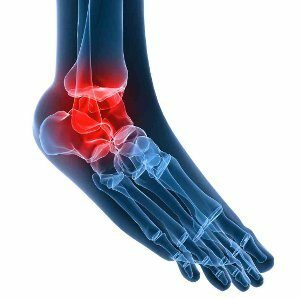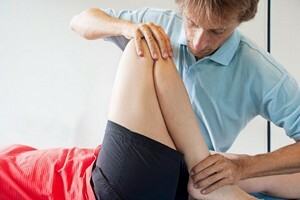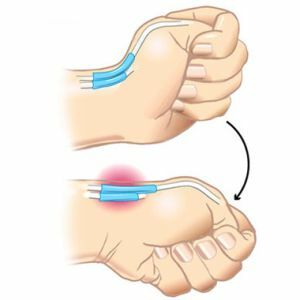 Tendovaginitis is considered a fairly dangerous inflammatory disease that can affect a wide variety of parts of the body.
Tendovaginitis is considered a fairly dangerous inflammatory disease that can affect a wide variety of parts of the body.
The ankle joint is not an exception, the defeat of which can lead to strong pain and limited mobility.
To prevent the emergence of dangerous complications, if you have symptoms of tendovaginitis, you should immediately consult a doctor.
Contents of the article
- Who is at risk?
- What can lead to an inflammatory process?
- Classification
- Symptoms of the development of the disease
- Treatment of the disease
- Complications of the pathology
- Preventative measures
Who is at risk?
This term is commonly understood as an acute inflammatory process of tendon sheaths. It is most often localized in the area of the external ankle or the anterior surface of the joint.
However, sometimes the pathological process affects the inside of the ankle.
This disease usually occurs in people who experience frequent and intense stress on the lower limbs. Often, this pathology is found in military personnel and is associated with long transitions.
It is also diagnosed in professional athletes - in particular, skiers and skaters. In addition, she is exposed to ballet dancers.
In addition to the professional form of tendovaginitis, the development of the disease occurs after prolonged high-intensity work. In addition to external factors, the appearance of pathology is affected by congenital pathology of the legs.
What can lead to an inflammatory process?
The development of tendovaginitis of the ankle joint is caused by wounds and purulent lesions of nearby tissues. It is through them that the pathogenic microorganisms can enter pathogenic vaginas.
Pathology can be primary or secondary. In the second case, the disease develops as a result of the appearance in the body of an inflammatory process of an infectious origin.
However, this factor is extremely rare. In most cases, the stenotic form of the disease is diagnosed - non-infectious, professional tenosynovitis.
Another factor in the development of ankle joint pathology is varicose veins. It develops as a result of degenerative processes occurring in the synovial membrane of the tendon sheath.
Classification
The disease can have a very different course, and therefore it is classified according to several criteria. 
Depending on the origin, there are such forms of an anosvoid ankle joint:
- aseptic - it is divided into reactive, post traumatic and professional;
- infectious - this category is divided into a specific and nonspecific form of the disease.
By nature of the inflammatory process, there are such types of disease:
- serous;
- serous-fibrinous;
- purulent.
Depending on the nature of the course of the disease, tendovaginitis can be acute or chronic.
Symptoms of the development of the disease
After prolonged physical overstrain, for example, a prolonged transition, with this disease in the tendon sheath may appear serous effusion.
The basis of serous or serous-fibrinous disease in some cases is rheumatic pathology or gonorrheal inflammation.
In the direction of the tendon sheath, there is a limited swelling of the elongated form. Often, it contains serous fluid. Also, with the strain of certain tendons, pain can occur. When crepitating, a slight crack appears.
The tubercular form of an ankle tensodaginitis proceeds in the form of a hygroma or has a fungiform form. Chronic thickening of the synovial vagina is located on the outer or anterior surface of the joint. Sometimes it does not have an effusion, but it can sometimes increase.
Pathology is long-lasting. The functions of the joints, as a rule, are not violated, but due to inflammatory changes, movements are significantly complicated. At the same time, there may be a tuberculous lesion of bones, tendinous vaginas or joints.
In this case, the pathological process from the tendon vagina quite rarely passes to the joint.
Treatment of the disease
To cope with this serious disease, you need to use general and local means. It is mandatory to use drugs for general strengthening of the immune system. 
When infectious disease of the body shows the use of antibacterial agents.
If a tuberculous tenosynovitis is detected in a person, they are prescribed special anti-tuberculosis therapy. To cope with the aseptic form of pathology, the patient is prescribed the use of non-steroidal anti-inflammatory drugs.
The doctor may prescribe acetylsalicylic acid. You can also use indomethacin or butadione.
As for the local treatment, warmed compresses are applied to the affected ankle joint. In addition, a gypsum board can be used.
After relief of the acute process, the tactics of treatment should be changed. The person is prescribed physiotherapy:
- ultrasound;
- microwave therapy;
- UHF.
When the purulent process develops, the tendon vagina of the joint should be urgently opened and the drainage procedure should be carried out.
For the treatment of the chronic form of tendovaginitis of the ankle, physiotherapy is used. 
In addition, it is necessary to perform:
- massage;
- paraffin applications;
- therapeutic mud;
- electrophoresis;
- therapeutic exercise.
If this occurs, the physician should perform a puncture of the tendon sheath and introduce such drugs:
- non-steroidal anti-inflammatory drugs;
- antibacterial directed agents;
- mixture of hydrocortisone and novocaine.
With the persistent development of creping tendovaginitis, doctors are forced to prescribe X-ray therapy. Usually 1-2 symptoms are enough to eliminate the symptoms of the disease.
Complications of pathology
If the disease was detected at the initial stage of development and the necessary measures are taken in a timely manner, the outlook is favorable.
Approximately two weeks after the onset of the illness, recovery occurs. In a couple of weeks, the patient is fully functional.
If a person has been diagnosed with purulent tendovaginitis and a surgical operation was performed to open the tendon, there is a high risk of impaired joint function.
In general, tendovaginitis is considered a serious enough inflammatory disease, which leads to the defeat of the tendon sheath. If you do not start treatment on time, very dangerous complications can develop - suppuration, necrosis of tendons, sepsis.
Preventative measures
 To prevent the infectious form of the disease, one must adhere to the rules of personal hygiene. It is very important to disinfect any skin damage in time.
To prevent the infectious form of the disease, one must adhere to the rules of personal hygiene. It is very important to disinfect any skin damage in time.
If a person has an open wound, antiseptic dressing is recommended to prevent infection with bacteria.
To prevent occupational diseases, you need to take breaks in work. After the end of the work day, you should perform a foot massage. A good result will help to achieve and foot baths - they have a wonderful relaxing effect .
Tendovaginitis of the ankle is an extremely serious disease that can not be ignored. Without adequate and timely treatment, this pathology can lead to the development of dangerous complications. Therefore at the first malaise it is necessary to address to the doctor.



